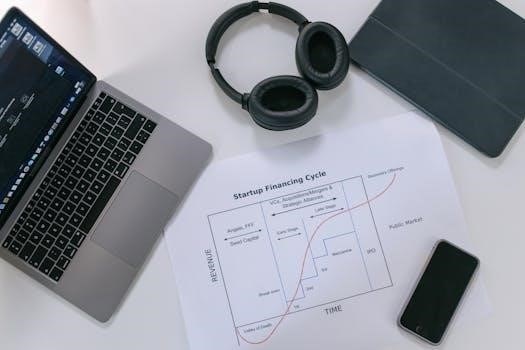BRIEF-A Questionnaire PDF⁚ An Overview
The BRIEF-A, or Behavior Rating Inventory of Executive Function-Adult Version, is frequently accessed as a PDF document. This format allows for easy distribution and completion. The PDF version maintains the questionnaire’s structure, enabling convenient printing and electronic use, essential for assessments.
What is the BRIEF-A?
The Behavior Rating Inventory of Executive Function-Adult Version (BRIEF-A) is a standardized assessment tool designed to capture an individual’s perceptions of their own executive functions, or how they regulate their behavior and emotions in daily life. It’s a questionnaire completed by the individual themselves, providing a subjective measure of executive functioning in adults aged 18-90 years.
The BRIEF-A assesses various aspects of executive function, including inhibition, shifting, emotional control, initiation, working memory, planning/organization, task monitoring, and organization of materials. It includes scales that correspond to these areas, providing scores that reflect an individual’s strengths and weaknesses in different aspects of executive functioning.
Unlike direct performance-based neuropsychological tests, the BRIEF-A captures real-world manifestations of executive function deficits, such as difficulties in planning tasks, managing time, controlling impulsive behavior, or maintaining focus. These everyday challenges may not always be evident in traditional clinical settings.
The BRIEF-A can be used in various clinical and research settings to help identify and understand executive function deficits in adults with neurological conditions, psychiatric disorders, or other conditions that may affect executive functioning. Its results can inform treatment planning, rehabilitation strategies, and educational interventions.
Target Audience and Applications of BRIEF-A
The BRIEF-A is primarily targeted towards adults aged 18 to 90 years, encompassing a broad spectrum of individuals. This includes those with neurological conditions such as traumatic brain injury (TBI), stroke, multiple sclerosis, and dementia, where executive function deficits are often prevalent. It is also applicable to individuals with psychiatric disorders like ADHD, depression, anxiety, and schizophrenia, as these conditions can also impact executive functioning.
Beyond clinical populations, the BRIEF-A can be utilized in research settings to investigate the relationship between executive functions and various cognitive, emotional, and behavioral outcomes. Researchers may use it to study the effectiveness of interventions designed to improve executive function skills.
The applications of the BRIEF-A are diverse. Clinically, it aids in the identification and characterization of executive function deficits, informing diagnostic decisions and treatment planning. It can help pinpoint specific areas of difficulty, such as planning, organization, or working memory, allowing for targeted interventions. In rehabilitation settings, the BRIEF-A can track progress and measure the impact of interventions aimed at improving executive function skills. Furthermore, it can be used in educational and vocational settings to understand how executive function challenges may impact academic or work performance, guiding appropriate accommodations and support.
Distribution Methods for Questionnaires
Questionnaires, including the BRIEF-A, employ diverse distribution methods to reach the intended audience effectively. Traditionally, paper-based questionnaires were the primary mode, involving physical printing and mailing to participants. This method remains relevant in situations with limited internet access or when face-to-face interaction is desired, like in-person surveys or clinical settings. However, it can be resource-intensive in terms of printing, postage, and data entry.
The rise of technology has led to the widespread adoption of online questionnaires, offering numerous advantages. These digital forms can be distributed via email, embedding links in websites, or through social media platforms, enabling broad and rapid dissemination. Online survey platforms like Google Forms, SurveyMonkey, and Qualtrics provide user-friendly interfaces for creating, distributing, and collecting responses.
Another method involves telephone surveys, where interviewers administer the questionnaire verbally over the phone. This approach allows for clarification of questions and can reach individuals who may not have internet access. In some instances, questionnaires are integrated into face-to-face interviews, serving as a structured guide for collecting responses.
The choice of distribution method depends on factors such as the target audience, research budget, desired response rate, and the complexity of the questionnaire.

Structure of a Well-Designed Questionnaire
A well-designed questionnaire, crucial for accurate data collection, adheres to a specific structure. It begins with a clear and concise introduction, stating the survey’s purpose and ensuring participant confidentiality. This fosters trust and encourages honest responses. Grouping similar questions together ensures a logical flow, transitioning from general to specific topics.
The initial questions should be easy and engaging, capturing the respondent’s interest. Complex or sensitive questions are best placed in the middle, once rapport is established. Open-ended or optional questions should conclude the questionnaire, allowing participants to share additional feedback or insights.
Clarity and brevity are paramount to avoid overwhelming respondents. Questions should be unambiguous and avoid jargon. Response options must be mutually exclusive and exhaustive, covering all possibilities. A pilot test of the questionnaire is essential to identify and address any ambiguities or issues before widespread distribution. Attention to these structural elements enhances the quality and reliability of the collected data. Furthermore, visual appeal and a professional layout can improve response rates.

When to Use a Questionnaire
Questionnaires are valuable tools for collecting data from a large audience efficiently and at a low cost. They are particularly effective when uniform responses are needed across participants, such as in large-scale surveys, market research, or social science studies. Questionnaires excel at gathering quantifiable data, which can be easily analyzed statistically.
Consider using a questionnaire when seeking information on attitudes, beliefs, behaviors, or demographics from a broad sample. They are ideal for situations where anonymity is important to encourage honest responses on sensitive topics. Online questionnaires offer convenience and wide reach, while paper-based questionnaires may be more suitable for populations with limited internet access or in face-to-face settings.
However, questionnaires may not be appropriate for research that requires in-depth responses or personal interaction. Qualitative methods like interviews or focus groups may be better suited for exploring complex issues in detail. The choice of method should align with the research objectives and the nature of the data needed.

Validity Considerations for BRIEF-A Data
When interpreting BRIEF-A data, it is essential to carefully consider the validity of the results. The inherent nature of rating scales introduces potential bias. Begin by examining the protocol for missing data. Significant missing data can compromise the validity of the scores.
Consider response style. Are the ratings overly positive or negative? Inconsistent responding can also affect validity. Compare self-reports with informant reports when available. Discrepancies between these sources may indicate issues with insight or reporting bias.
Examine clinical history and collateral information to see if the BRIEF-A results align with other sources. If there are significant inconsistencies, explore potential explanations. Validity scales, if available, should be reviewed to assess response bias.
Cultural factors and language proficiency can influence responses. Ensure the individual understands the questions. Be mindful of cultural norms that might affect rating behavior. Thorough consideration of these factors enhances confidence.
Relationship Between BRIEF-A and Executive Function
The BRIEF-A is specifically designed to assess various aspects of executive function (EF) in adults. Executive functions are a set of cognitive processes that are essential for goal-directed behavior, including planning, organization, working memory, and self-regulation. The BRIEF-A provides a standardized measure of these functions as observed in everyday life.
The questionnaire captures views of an individual’s executive functions or self-regulation abilities in their daily environment. It helps identify difficulties in areas such as inhibition, shifting, emotional control, initiation, working memory, planning/organization, task monitoring, and organization of materials.
By measuring these specific domains, the BRIEF-A offers valuable insights into the impact of executive dysfunction on daily functioning. It helps clinicians and researchers understand how EF deficits manifest in real-world settings, complementing information obtained from neuropsychological tests.

BRIEF-A and Other Assessment Tools
The BRIEF-A is often used in conjunction with other assessment tools to provide a comprehensive evaluation of an individual’s cognitive and behavioral functioning. It’s common to combine the BRIEF-A with neuropsychological tests that directly measure cognitive abilities, such as attention, memory, and executive functions. This combination allows for a more complete understanding of the individual’s strengths and weaknesses.
For example, the BRIEF-A might be paired with the Delis-Kaplan Executive Function System (D-KEFS) to assess both behavioral manifestations of executive function deficits and performance on specific executive tasks. Similarly, it can be used alongside measures of intellectual ability or adaptive behavior to provide a broader context for understanding an individual’s functioning.
Additionally, the BRIEF-A can be compared with other self-report or informant-report questionnaires that assess related constructs, such as mood, anxiety, or personality traits. This helps to differentiate between executive dysfunction and other psychological or emotional factors that may be contributing to the individual’s difficulties.
Questionnaire Templates and Customization
While the BRIEF-A itself is a standardized assessment, the concept of questionnaire templates and customization is relevant to related contexts. When creating questionnaires for research or clinical purposes, templates can provide a structured framework to start from. These templates often include pre-written questions, response scales, and formatting guidelines that can be adapted to fit specific needs.
Customization is essential to ensure that a questionnaire is appropriate for the target population and the research question being addressed. This may involve modifying existing questions, adding new questions, or changing the response options. It’s important to carefully consider the wording of questions to ensure that they are clear, concise, and unbiased.
Furthermore, the layout and design of a questionnaire can impact its usability and the quality of the data collected. A well-designed questionnaire should be visually appealing, easy to navigate, and free of errors. Customization can also involve incorporating features such as skip patterns, branching logic, and validation rules to improve the accuracy and efficiency of data collection.